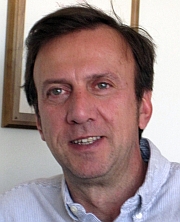
David M. Ferguson, PhD
Titles
Education
PhD, University of South Florida (Chemistry), 1989
Bachelors, Bucknell University (Chemistry), 1983
Postdoc, University of California (Pharmaceutical Chemistry), 1991
Fellowships
Biography
Bio
David M. Ferguson is a Professor of Medicinal Chemistry, a Fellow of the Supercomputing Institute for Digital Simulation and Advanced Computation, an Associate Director of the Center for Drug Design, and a graduate faculty member of several interdisciplinary programs across the University.
Awards & Recognition
- Pharmacy Teacher of the Year University of Minnesota 2001, 2002, 2008, 2009, 2010
- President's Distinguished Faculty Mentor University of Minnesota 1999/01
- James A. Shannon Directors Award National Institutes of Health 1996/97
- Advisor, Merck Research Scholar Program AACP 1996/97
- Pharmacy Teacher of the Year University of Minnesota 1996/97
Research Summary
Research is the foundation to scholarship. Research in my lab is primarily focused on the application of chemistry to solving problems related to biomolecular structure, function, and activity, especially as it relates to drug design and discovery. More precisely, we apply chemical synthesis, biological screening, and structural biology to understand the basis to molecular recognition and the physical forces that drive function.
For example, our work on opioid recognition defined the first structural models by which highly selective agonists and antagonists could be rationally designed.
In the field of cancer and topoisomerase function, we designed characterized DNA binding agents that selectively inhibited topoisomerase II by threading DNA duplex and quadraplex structures thereby blocking strand cleavage. These catalytic inhibitors were further shown to avoid formation of linear DNA fragments following treatment reducing the toxic effects commonly associated with topoisomerase poisons. Using focused library synthesis and flavivirus screening, we discovered the first non-nucleoside inhibitors or the West Nile virus. These compounds have shown further versatility in other emerging tropical diseases and have the added advantage of being simple and cost effective to produce.
Our most recent efforts in fighting cancer have focused on immunostimulants targeting TLR7 and TLR8. Our work has not only defined the selectivity elements leading to high affinity binding to TLR7/8 but has shown some ligands may activate an alternative pathway in the production of specific cytokines, such as IL-1b and IL-12, required to boost antigen specific cellular responses of the immune system. More details of this work and more can be found at my website and in my published work.
Publications
- Yang M, Larson PG, Brown L, Schultz JR, Kucaba TA, Griffith TS, Ferguson DM. Toll-like receptor 7 and 8 imidazoquinoline-based agonist/antagonist pairs. Bioorg Med Chem Lett. 2022 Mar 1;59:128548. doi: 10.1016/j.bmcl.2022.128548. Epub 2022 Jan 18. PMID: 35051578.
- Escalante DE, Aldrich CC, Ferguson DM. Parameterization and Application of the General Amber Force Field to Model Fluoro Substituted Furanose Moieties and Nucleosides. Molecules. 2022 Apr 19;27(9):2616. doi: 10.3390/molecules27092616. PMID: 35565967; PMCID: PMC9101125.
- Bhatnagar, S., Revuri, V., Shah, M., Larson, P., Shao, Z., Yu, D., Prabha, S., Griffith, T. S., Ferguson, D., & Panyam, J. Combination of STING and TLR 7/8 Agonists as Vaccine Adjuvants for Cancer Immunotherapy. Cancers, 14(24), 6091. doi: 10.3390/cancers14246091